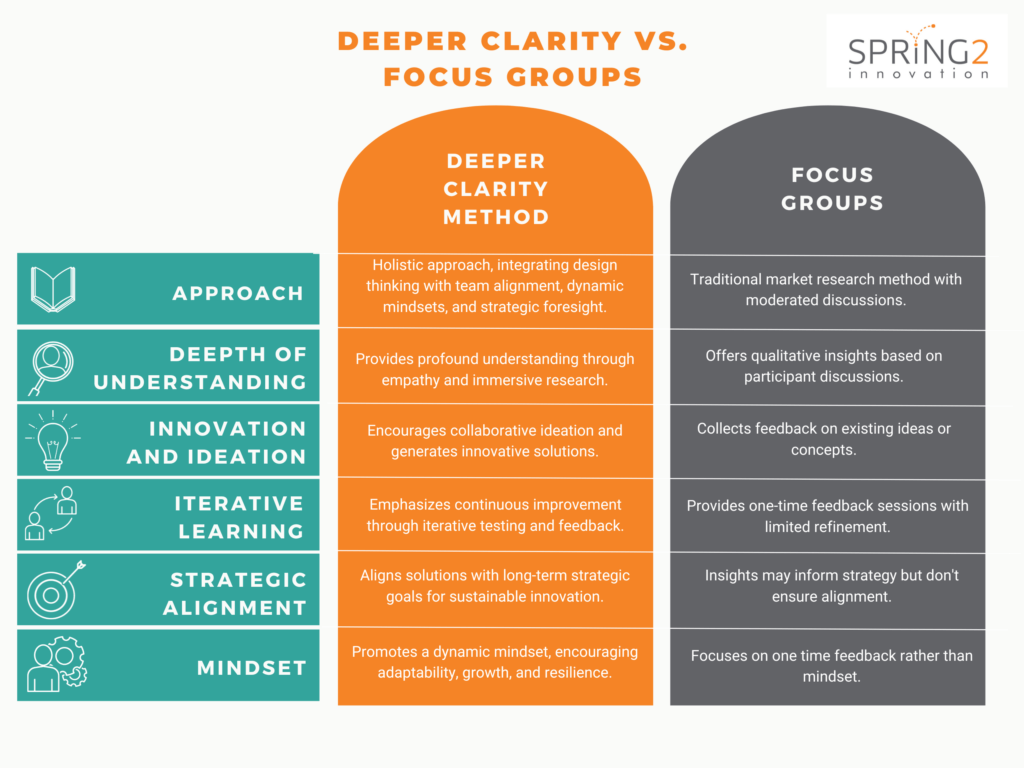In the quest to understand customer needs and drive innovation, organizations often grapple with choosing the right approach. One popular method is using traditional focus groups.
Focus groups are a traditional market research method involving a moderated discussion with a diverse group of participants that represents the target audience. These groups provide qualitative insights into customer opinions, preferences, and attitudes towards a product, service, or concept. While they can help to explore specific topics and gather in-depth insights that may inform strategy, focus groups do not inherently ensure strategic alignment. They also limit the scope of innovation, as they primarily collect feedback on existing ideas or concepts.
The Deeper Clarity Method is a holistic approach that combines the principles of design thinking with team alignment, growth mindsets, and strategic foresight. This method emphasizes empathy, collaboration, iterative learning, and strategic alignment to drive innovation and problem-solving.

Deeper Clarity vs. Focus Groups
The depth of understanding that each method provides is a key differentiator. Focus groups can be a valuable tool within the empathy phase of design thinking, providing rich, qualitative data that can help teams understand end users better and design solutions that will meet their needs. However, focus groups represent just one tool from a broader approach.
The Deeper Clarity Method offers a profound understanding of customer needs through empathy and encourages collaborative ideation by leveraging diverse perspectives to generate innovative solutions. Applying an iterative approach allows continuous improvement based on real-world feedback, as opposed to the one-time feedback sessions with limited opportunities for iterative refinement offered by focus groups.
Aligning solutions with long-term strategic goals is also a crucial part of the Deeper Clarity Method, ensuring that innovations are sustainable and aligned with the organization’s vision. This strategic foresight is often missing in the isolated feedback from focus groups.
Additionally, the Deeper Clarity Method promotes a dynamic mindset. A dynamic mindset encompasses the principles of a growth mindset, where challenges are viewed as opportunities, and learning from failures is encouraged. However, it also includes being adaptable and open to continuous change. This mindset fosters resilience and continuous improvement, enabling teams to turn setbacks into valuable learning experiences and innovation drivers.
While both the Deeper Clarity Method and focus groups offer valuable insights, they serve different purposes and are suited to different stages of the innovation process. The Deeper Clarity Method is ideal for organizations seeking a comprehensive, empathetic, and strategic approach to innovation. It fosters a culture of continuous learning, collaboration, and growth, driving sustainable and impactful solutions. On the other hand, focus groups are effective for gathering qualitative feedback on existing ideas or concepts, providing a snapshot of customer opinions and preferences.
Choosing the right method depends on your organizational goals, the stage of your innovation process, and the depth of insights required. By understanding the strengths and limitations of each approach, you can make an informed decision that best supports your innovation journey.
_____
RELATED BLOGS
_____
Ready to transform your approach to innovation with the Deeper Clarity Method?
Contact us today to learn how we can help you achieve your strategic goals.
Schedule a Free Consultation